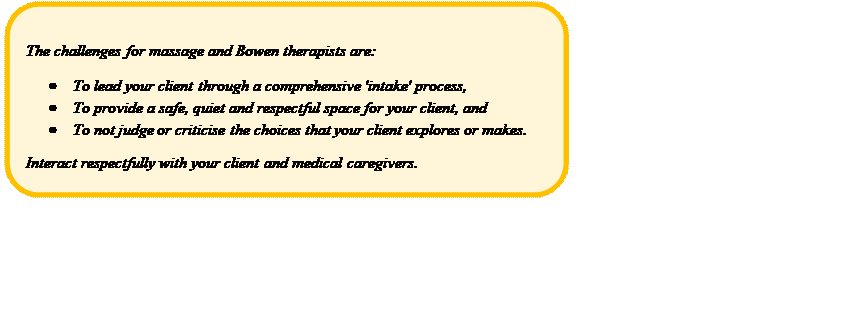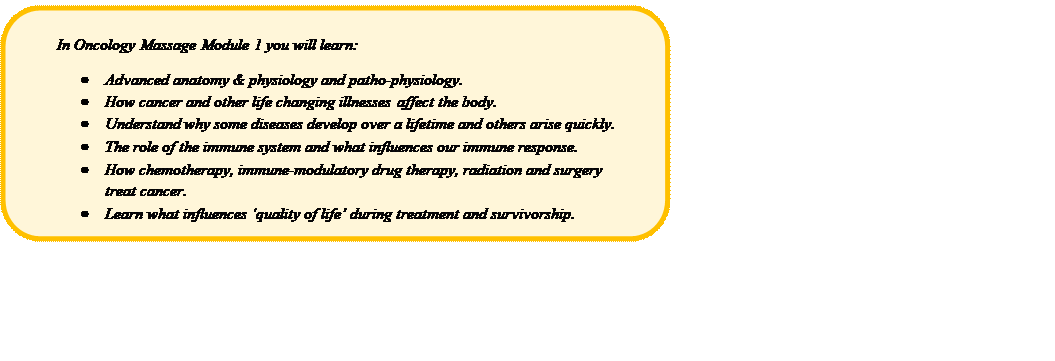An all-round Oncology Massage Blueprint from Scientist and Massage Therapist Eleanor Oysten of Oncology Massage Global

Oncology Massage Global (OMG) is a leading international, integrative training group that helps massage therapists and allied health providers upgrade their tactile skills to confidently work with clients experiencing complex health issues.
When massage therapists train with OMG they create a safe working environment for their clients, doing no harm, and providing a unique and much needed service.
We all have clients with a diagnosis of cancer that book into our massage clinic. Some clients have a history of cancer and are living well. Most people don’t tell us about their history accurately.
Over the last 20 years, the growing community awareness of the medically proven benefits of Oncology Massage has increased demand for it. To ensure safe outcomes for our clients, therapists must have a working knowledge of Oncology Massage techniques and contra-indications.
For this reason, we created the Oncology Massage Blueprint. Follow the Blueprint and you will do no harm and with specialised training you will have the skills to confidently work with clients who have a cancer diagnosis, a history of cancer or are at the end of their life.


There are three areas of focus for massage therapists wanting to transition to oncology massage:
- Understanding the science of cancer and cancer treatment.
- Adapting your professional massage skills to work with all illnesses. Manage contraindications.
- Increasing your awareness of the physical, emotional and spiritual needs of people on the edge of life.
When you understand the challenges faced by people with cancer or in cancer treatments your massage is subtly changed and compassionately modified. A cancer diagnosis and treatment changes clients physically and emotionally. You must change how you work with sick clients. You must change your massage pressure, what part or parts of the body you massage and how you position a client to receive a massage. The challenge of changing your massage technique is the first step towards a successful Oncology Massage.
SCIENCE
One of the fastest growing areas of medical science is cancer research, drug therapy and treatment protocols. You cannot keep up, even GPs are challenged by the speed of change. When you have strategies and communication skills around the science and the medical language of cancer treatment your clients begin to trust you. All this information is readily available to patients and to you as well.
Clients usually know the name of the drugs that they are receiving and you need to have a section in your in-take form where they can write them down. Your job is to ‘look them up’ between visits so you understand how they work and the common side effects. Your client will feel supported and you can assist them to achieve the goals of their medical team.
Understanding how organs and cells work, change or respond to diseases or treatment for any life limiting disease ensures that you are aware of any potential problems that cancer clients might be facing or presenting to you at your clinic.
DISEASE PROCESS
Behind every disease there is a period of inflammation, chronic or acute. Systemic inflammation slowly leads to tissues and organs being compromised and then they don’t function properly. It can take a long time to feel sick. Often a diagnosis of cancer is a complete surprise…a shock.
TREATMENT PROTOCOLS
In the past 50 years we have seen the rise of pharmaceuticals for most diseases. Chemotherapy for cancer is a comparatively new treatment and is still being ‘tested’ for efficacy. Radiotherapy has been used for cancer since the last few years of the 19th century and, with advances in physics and computers, radiation is now finely targeted and side effects are reduced.
BIOLOGY OF BELIEF
The new science of epigenetics leads us to understand that ‘what we think and feel’ affects every cell in our body. Human transplant technology has led to a new and exciting understanding of psycho-neuro-immunology (PNI). When you work as a massage or Bowen therapist what you think or feel matters – if you feel pity and fear that energy flows through you to your clients.
All the tactile skills you learnt in massage school or during Bowen training are the springboard for your work with Oncology Massage and/or Bowen clients with a cancer story.
Most of the massage and tactile skills that you have learnt up until now are suitable for you to safely adapt and use with any client with cancer or in cancer treatment, in fact anyone experiencing major health challenges, like heart disease or diabetes or neurodegenerative diseases e.g. Parkinson’s disease.

CLEAR MANAGEMENT OF CONTRAINDICATIONS
You need to know when to STOP the massage and send/take the client to the doctor or hospital.
The signs are heat, redness, pain and pallor. The symptoms could be caused by blood clots, infections and abnormal reactions of treatment. If you notice these changes, you must stop the massage and send for or call a doctor.
Nobody is untouchable with Oncology Massage techniques, from diagnosis to the end of life. See S4OM website (https://www.s4om.org/) for articles on this topic.
Continuing education in the field of Oncology Massage is vital.
ADAPT TECHNIQUES
Changing and adapting your massage skills to medically proven Oncology Massage techniques is essential to ensure safe, doing no harm, outcomes for your clients. The science is important; it is what helps you understand the skill changes you must embrace. You need to reduce your pressure so that you don’t ‘over work’ the fascia and release toxins too rapidly (clients will get flu symptoms for up to a week); ensure that the area you massage is a ‘safe site’ to massage (not recently irradiated or have a surgical wound or scar in need of healing) and the position your client is resting in for the massage is very comfortable e.g. the position that they can sleep in.
Oncology massage is actually “medical massage” and the deep relaxation it offers will support everyone with a life-changing or life-limiting illness. When you massage clients on the edge of life your conversation and general attitude is almost as important as your skilled touch. If you are feeling fearful or judgmental you limit the client’s capacity to find their own best answers (feelings). Projection of your own beliefs and attitudes is less than helpful when the other person is grappling with life or death.
If a massage therapist can ‘hold the space’ in silence, sometimes in the midst of noise or chaos, they create an environment where self knowing and wisdom can blossom. I’m not saying “don’t talk” to your clients while they are on the massage table or during the intake process; I’m encouraging you to be mindful of when and what you say if you are working with clients on the “edge of life”.
Remember every word you say may be repeated (often out of context) to the doctor or nurse at the next hospital visit.

AWARENESS
Professional awareness as an oncology massage therapist includes:
- Understanding the complexities of your client’s life
- Understanding your own emotions, especially around your own mortality
- Understanding the role of massage in the wider medical community, the local culture and the client’s family.

CLIENT AWARENESS
Client awareness begins at the first contact with your client. You begin to assess their mood, posture, energy level and confidence from their tone of voice, even if it is over the phone. You must adapt your response to mirror theirs so that they don’t feel overwhelmed by your energy that is usually higher than their own. Slowing your breathing to match the client’s respiration rate is an excellent way to begin an Oncology Massage.
SELF-AWARENESS
When you begin to notice your own reactions to a client’s story, you begin to practise self- awareness. With self-awareness you are conscious of your own behaviour, thoughts and prejudices. When you are reacting to elements from your own experience or life story rather than walking alongside your client as they experience cancer, you could be projecting unwanted energy onto your burdened client. Judging or criticising the choices of your client negates the benefits of the massage. Your well-meaning advice is the last thing others need, especially when they are fearful and worried.
CULTURAL AWARENESS
You can learn professional awareness and communication skills to navigate the challenges. When you offer a professional response to your client with cancer, in cancer treatment or with a history of cancer, uncluttered by your fears and emotions, a truly beneficial professional relationship develops.


Oncology Massage Global makes a meaningful contribution to the Massage Profession, impacting and expanding compassion by teaching massage therapists a step-by-step method. It also means you don’t burnout or do harm to your clients. Rather, you continue gathering experience and meaningfully contribute to the cancer-wellness community.

Would you like to help the growing number of people with cancer? Book a ‘Cancer Confidence Session’ with Eleanor or Monica. Email: eleanor@oncologymassageglobal.com.au (English) ormonica@oncologymassageglobal.com.au (Spanish)
Eleanor Oyston,
Research Fellowship, UTS, ARCCIM International CIM Research Leadership Fellow. CT(ASC), Dip RM, Bowen Therapist.
After over 25 years in medical technology specialising in diagnostic cytology (diagnosing cancer), Eleanor was employed for 10 years as Senior Technical Officer, developmental neuroscience research lab at the John Curtain School of Medical Research, Australian National University.
Eleanor embraced a midlife career change attaining a Dip RM and studied Bowen Therapy. She established a multidisciplinary clinical practice in Canberra and taught pathophysiology to massage students. Eleanor worked with Petrea King facilitating retreat programmes for people with cancer and their carers for nine years. During this time, she developed and established Oncology Massage Training and later Oncology Massage Global (OMG).
Eleanor has taught Oncology Massage in Australia, New Zealand, Germany, Hong Kong, Spain, The Netherlands as well as presenting at international conferences in Australia, Munich Germany, Minneapolis USA and Barcelona Spain. She has also developed in-hospital training at the Olivia Newton John Centre, Melbourne and the Life House, Royal Prince Alfred Hospital, in Sydney.
In 2017 Eleanor established OMG, an international consultancy designed to inform the development of oncology massage in hospitals and general practice clinics globally.
In March 2020 Eleanor was competitively selected to the fellowship team with Distinguished Prof Jon Adams at UTS: ARCCIM International CIM Research Leadership Program.
During her time as a Research Fellow, UTS, she has participated in publishing papers in conjunction with international CIM leaders and developed Research Capacity Building pathways in tactile therapies, presented at the MMA National Conference and BTFA National Conference 2024. Her UTS Fellowship concludes November 2024.
Contacts:
Web: www.oncologymassageglobal.com.au
Kate Butler BA, CLT, Dip Ther Mass, Cert IV T&ALead Facilitator Spain, Argentina, Australia, USA kate@oncologymassageglobal.com.auinfo@oncologymassageglobal.com.auph:61 418 335 759
https://oncologymassageglobal.com.au/